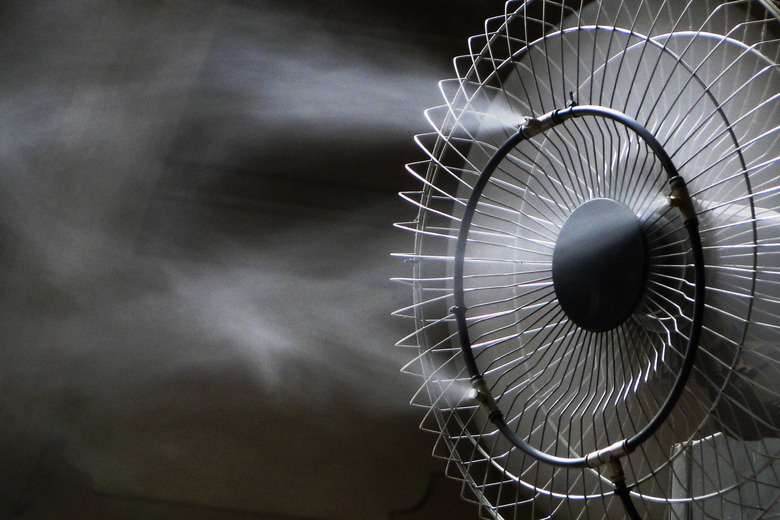How To Make An Electric Fan
With supplies readily available at home, a few recyclable items, some batteries and a small toy motor, you can create a battery-powered electric fan for a science project. What's even more appealing is that it doesn't have to break the bank, making the project an affordable, but interesting endeavor.
Things Needed
- 6- or 9-volt battery
- 6- or 9-volt DC toy motor
- Extra wire
- Soldering gun
- Section of small-diameter PVC pipe
- PVC ratchet cutter
- 5-by-5-by-3-inch tall Styrofoam block
- Vise clamp
- Empty plastic water or soda bottle
- Scissors and/or a razor knife
- Glue
- Insulating tape
- Switch
1. Choose the Voltage of Power Source
Choose a DC toy motor and the batteries to match it as the power source for the electric fan. If the DC toy motor does not come with wires, solder some wire onto one end of the toy motor. After soldering, secure exposed wire with insulating tape to minimize shock.
2. Build the Base and Stand
Remember to choose a small-diameter PVC pipe so that it won't be too heavy for the Styrofoam block piece. Determine the height of the stand, and cut the PVC pipe to that desired height. Use the vise clamp to secure the pipe to make it easier to cut with the PVC ratchet cutter. Use the razor knife to cut a circle in the center of the Styrofoam base. Make sure the size of that circle being cut is the exact same diameter as the PVC pipe. Set the pipe within the cut-off circle and apply glue to secure the pipe in place. Make certain it does not move while the glue dries.
3. Create the Fan Blades
Create the fan blades from a plastic soda bottle, after removing the label and cleaning the bottle. Lay the bottle on its side and cut the bottle in half through its "equator" while keeping the bottle cap on. After evenly cutting the bottle in half, wrap a tape measure around the bottle exterior to measure out its circumference. Mark off equidistant points around the exterior of the bottle's circumference as guides for cutting the plastic to create the blades that radiate from the bottle cap. Once the blades have been cut into strips, push them back until they appear like fan blades or windmill blades. The blades can number three or four in total, so cut off the excess blades, making sure the final blades are equidistant from one another. Use the scissors to round the ends of the fan blades.
4. Prepare the Wiring of the Electric Fan
Remove the bottle cap from the fan blades and pierce a hole through its center with a pair of scissors. This is the hole through which the pointed end of the toy motor is to pierce through. Secure the pointed end to the bottle cap with glue. Then affix the fan blades to the bottle cap by screwing the cap back on to the neck of the bottle. Next work on the wiring of the stand. Recall that the other end of the motor has wires dangling from it. Take those wires and lace them through the PVC pipe so that they dangle from the bottom of the base. On the top of the stand, glue the motor to the stand to secure it.
5. Assemble the Switch
Connect the wires at the bottom of the base to a switch. Wire the switch to the battery power source. The switch turns the DC-powered motor on to start the electric fan blades moving.
TL;DR (Too Long; Didn't Read)
Using recyclables provides a good way to keep things within a budget. Used tissue rolls or used paper towel rolls can be used for the stand in place of the small-diameter PVC pipe. And an empty plastic water bottle or empty plastic soda bottle can be cut to form the fan blades.
Warning
Even though the battery power source measures only 6-volts or 9-volts, it is still good practice to have insulating tape to secure the wiring to minimize any shock, no matter how small.
References
- Washington State University: Electric Motors
- Consumer Product Safety Commission: Assessment of Portable Electric Fans
- MSN.com: How to Make an Electric Cooling Fan
- YouTube: How to Make an Electric Table Fan Using DC Motor Homemade
- Department of Energy: Fans for Cooling
- University of Colorado, Boulder: Circuit Construction Kit — DC
- Northwestern University: Power System — How Do Batteries Work?
- YouTube: How to Make a Mini Fan from Water Bottles
- YouTube: How to Make an Electric Table Fan using Bottle – Easy Way
Cite This Article
MLA
Agravante, Mariecor. "How To Make An Electric Fan" sciencing.com, https://www.sciencing.com/electric-fan-4580420/. 11 April 2018.
APA
Agravante, Mariecor. (2018, April 11). How To Make An Electric Fan. sciencing.com. Retrieved from https://www.sciencing.com/electric-fan-4580420/
Chicago
Agravante, Mariecor. How To Make An Electric Fan last modified August 30, 2022. https://www.sciencing.com/electric-fan-4580420/
